
BY PETE McCALL, M.S.
This is the third article in a four-part series covering the new ACE Integrated Fitness Training Model.
The ACE Integrated Fitness Training (IFT) Model was developed to provide personal trainers with a systematic and comprehensive approach to exercise programming that integrates assessments and programming to facilitate rapport, adherence and behavior change, while also improving posture, movement, flexibility, balance, core function, cardiorespiratory fitness, muscular endurance and muscular strength.
The first two articles in this series provided an overview of the ACE IFT Model and examined the key concepts of Phases 1 and 2: Stability and Mobility, and Movement Training. The second article also introduced a template provided within the ACE IFT Model that progresses individuals in preparation for more traditional load and performance training, which are the focus of Phases 3 and 4. The purpose of this article is to provide an overview of Phases 3 and 4, which address the application of external loads to movements to meet client goals related to muscular strength, endurance and hypertrophy, maximal strength and body-composition changes, and, if appropriate, competitive or performance-oriented goals.
Phase 3: Load Training
Phases 1 and 2 of the ACE IFT Model emphasize functional movement, specifically by addressing joint range-of-motion, muscular endurance, core stability and movement efficiency, and serve as a necessary foundation for more advanced training techniques. The purpose of the exercises in Phase 1 are to improve joint stability and mobility while enhancing the strength and endurance of the type I muscles responsible for core stability and good posture. Phase 2 is designed to teach a client how to move efficiently and effectively through the basic patterns of exercise. Once a client demonstrates that he or she can perform the basic movements of exercise while controlling his or her center of gravity over his or her base of support, it is time to progress the intensity of the training program by adding an external resistance, or load.
Clients seek the services of a personal trainer for a variety of reasons, including improved health and well-being, and it is not uncommon for new clients to cite “toning,” “sculpting” or “improving muscle definition” as primary reasons for beginning a fitness program. While the exercises in the first two phases are important for restoring movement efficiency, which is critical for improving overall health and wellness, they do not produce enough overload to help clients achieve goals that focus on fitness-based objectives such as aesthetic appearance.
Certainly, the most effective way to achieve a sculpted or toned look is through resistance training using external loads to enhance muscular strength. In addition, resistance training is effective for helping with weight loss and enhancing overall quality of life. However, progressing to resistance training before addressing muscular imbalances may actually worsen any existing dysfunctions and could lead to long-term injuries for the client. Taking a client through the first two phases of the ACE IFT Model should restore muscle-activation patterns and address any length-tension relationships or muscle imbalances, as well as enhance technical skills related to coordination and movement (Figure 1). When a client demonstrates improved posture and movement efficiency, it is time to increase the intensity of the training program by adding resistance, or an external load to the exercises. This is the focus of Phase 3: Load Training.

Assessments for Phase 3 Load Training
There are two ways to assess a client’s existing levels of muscular fitness. The first option is to test muscular endurance, which requires seeing how many repetitions a client can perform of a particular exercise before fatiguing. A second option is to test the client’s strength in a specific lift to determine his or her one repetition maximum (1RM). This assessment information can then be used to determine the loads for the exercise program, as well as measure the progress of the client’s program during the next testing session. Regular assessments are important in that they enable a client to see the results of their exercise efforts, which may also help facilitate long-term adherence. The ACE Personal Trainer Manual, 4th Edition, describes a variety of assessments that can be used to determine a client’s existing level of muscular fitness.
Programming Guidelines for Phase 3 Load Training
Exercise program design in the Load phase of the ACE IFT Model adheres to the principles of resistance training: Specificity, Overload, Progression and Reversibility (Table 1), as well as the American College of Sports Medicine (ACSM) Guidelines for Resistance Training (Table 2).
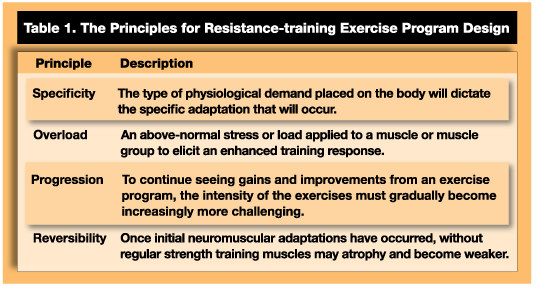
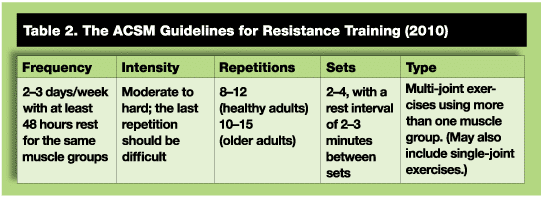
Phase 3 of the ACE IFT Model is intended to achieve the standard outcomes of resistance training: muscular endurance, hypertrophy (strength-endurance), strength and maximum strength. If the client’s goal is to develop lean muscle mass, for example, then the exercise program should be designed to progressively increase the training overload to stimulate growth. A well-designed Phase 3 resistance-training program applies the variables of exercise selection, intensity, tempo, repetitions, sets, rest interval and frequency to achieve a specific strength-based goal. Once a client reaches Phase 3, the bodyweight exercises used to promote core stability and movement efficiency in Phases 1 and 2 of the ACE IFT Model can now be used as a dynamic warm-up to prepare for the additional stresses of using an external load. The guidelines and principles establish the basic structure for developing an exercise program, but it is the application of the variables of program design that are responsible for the client’s results.
Following is a brief review of the variables of exercise-program design that can be applied to create a progressive training overload:
- exercise selection—the actual movements and exercises performed
- intensity—the amount of resistance or load used in an exercise expressed as a percentage of one-repetition maximum (1RM)
- repetitions—the complete range of motion (ROM) of the lengthening and shortening phase of the muscle action, expressed as the number of times the complete cycle is performed
- sets—the total amount of repetitions completed at one time
- tempo—the velocity at which the weight is moved
- rest interval—the time period between exercises that allows the muscles to recover and refuel to be able to perform more work. The actual length of the rest interval is determined by the load and the training outcome. The greater the load, the longer the rest period needed to restore the muscle’s energy pathways.
The combined total of the intensity (weight used), number of repetitions and sets completed is known as the volume of the workout. The number of workouts per training period can be classified by days, weeks, months or even years and is defined as the frequency of the exercise program.

Clients new to resistance training should aim for the low end of the ACSM guidelines and strive to complete two resistance-training sessions per week. As a client progresses and become stronger, frequency can be adjusted (Table 3), but should still allow appropriate rest time between workouts. It is your responsibility to closely monitor your client’s progress during Phase 3 and identify when it is time to adjust the intensity and volume of the program.

Phase 3 exercise selection can incorporate any type of resistance-training equipment including traditional strength-training equipment such as selectorized machines, medicine balls, cable machines, plate-loaded machines, barbells and dumbbells, as well as nontraditional equipment such as kettlebells, sandbags, stones or water-filled implements. Because of the sheer volume of possible resistance-training exercises, it is necessary to have a system for organizing the exercises in a logical sequence to provide the greatest results. Methods of organizing and sequencing exercises include grouping exercises based on body part (e.g., chest, arms or back), movements (e.g., push, pull or rotation), or by the relevance to an activity or sport. Regardless of which implements or method of organizing the exercises you use, it is important to pay attention to the client during every single lift and apply the M.O.V.E. acronym (see sidebar) to ensure that the client is using good form and muscular force to move the load (as opposed to momentum, which can cause injury).
Phase 4: Performance Training
Many clients with the aforementioned fitness goals of improving lean body mass, muscular definition or muscular strength will never need to progress past Phase 3. With the ACE IFT Model, it is possible to design programs that cycle between the different phases of strength training—endurance, hypertrophy and strength—to help clients avoid plateaus and efficiently achieve results (Table 4). However, for clients who are interested in training for athletic events—whether they are competing at the elite professional level or just want to be an injury-free weekend warrior—it will be necessary to progress to Phase 4 in the ACE IFT Model: Performance.
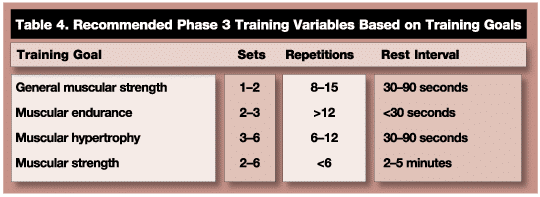
Performance training is also appropriate for clients who enjoy non-competitive recreational activities such as playing tennis, golf or pickup basketball with friends, or who are preparing for an adventure-style vacation like a ski trip, cycling across Europe or hiking Machu Picchu in Peru. For clients who have progressed through the three previous stages, have no movement restrictions or muscle imbalances, and who are interested in pursuing dynamic, challenging workouts, progressing to the Performance phase may be appropriate. Additionally, the safe application of power training in Phase 4 is an important component for older adults who seek to maintain their functional independence as they age.
While the purpose of the Load phase is to help a client increase his or her muscle force production, the intent of the Performance phase is to improve the velocity of muscle-force production by increasing the velocity of the stretch-shorten cycle (SSC—see box below) and minimizing the time it takes to convert from muscle lengthening to muscle shortening. This is called the amortization phase. Reducing the time of the amortization phase of the SSC greatly enhances a muscle’s ability to generate power. It is helpful to think of the SSC of a muscle as the spring in a pinball machine—if the spring is pulled back and held in a shortened position, it won’t produce the same amount of explosive force as when the spring is rapidly pulled and immediately released.
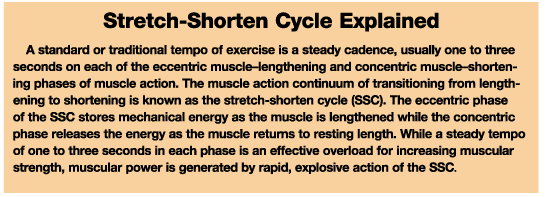
Many common machine-based exercises place the emphasis of the muscle action on the concentric phase, which is when the muscle has to generate the force to overcome external resistance. However, the greatest strength and performance increases come from minimizing the amortization phase of the SSC. Exercise selection in Phase 4 focuses on explosive exercises such as plyometric jumps to develop lower-body power, medicine-ball throws to improve upper-body power, or Olympic-style lifts to enhance total-body power output. The purpose of using plyometric or explosive exercises is to train the muscle to rapidly lengthen under a load so it can rapidly shorten to produce a high-resultant force.
Assessments for Phase 4 Performance Training
If a client meets all of the prerequisites for performance training and expresses an interest in increasing the intensity of his or her training program with power-based exercises, the next step is to assess the client’s current level of muscular power to determine the purpose and goals of the exercise program. It is essential to assess the client’s current level of power using tests like the vertical jump, horizontal jump or seated medicine ball chest-pass because the outcome will determine the client’s current muscular power output. This information can then be used to demonstrate progress as the client follows the Phase 4 program. Specific assessments and tests are described in Chapter 8 of the ACE Personal Trainer Manual, 4th Edition.
Programming Guidelines for Phase 4 Performance Training
For healthy adults with no muscle imbalances and good movement efficiency, the first three phases of the ACE IFT Model can be used to prepare a client for the high-stress, high calorie–expending exercises required to enhance muscle-power output. Training clients to increase their net power output will condition them to be able to do more work in less time, which can make their workouts more effective and efficient.
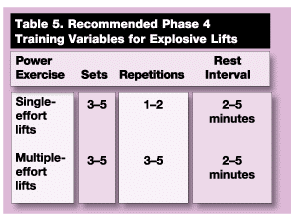
The same variables of program design that are applied to develop more strength in Phase 3 are used in Phase 4 programming; the major differences are in the intensity of the exercises and the total volume of work performed. Because Phase 4 exercises involve very high-intensity efforts, the number of repetitions is reduced and the rest intervals are increased to allow for appropriate rest and replenishment of energy stores between sets (Table 5).
When programming plyometric exercises in Phase 4, it is extremely important to start the client with low-intensity plyometric exercises to allow the musculoskeletal system to adapt to the faster SSC velocities before progressing to the higher-intensity exercises with more dynamic jumps or heavier loads (Table 6).

Precautionary Guidelines for Plyometric Exercises
Given the ballistic and high-impact nature of plyometric exercises, appropriate strength, flexibility and postural mechanics are necessary to avoid injury. The following recommendations are provided to reduce the potential for injury and increase the likelihood of client’s achieving their desired performance-based goals:
- Introduce clients to high-intensity, lower-body plyometric drills only after they have demonstrated the ability to successfully squat 1.5 times their body weight or complete five squat repetitions with 60 percent of their bodyweight in five seconds.
- Plyometric drills should be performed at the beginning of a training session after the completion of a dynamic warm-up (while clients are not fatigued) to reduce the risk of injury.
- Clients should not jump until they first learn how to land safely. Ensure that clients are capable of landing correctly by initially teaching small, low-intensity jumps and using appropriate landing techniques. (Refer to Chapter 10 of the ACE Personal Trainer Manual, 4th Edition.)
- Start with a low volume of low-intensity jumps and increase the volume of the plyometric exercises before increasing intensity (Table 7).

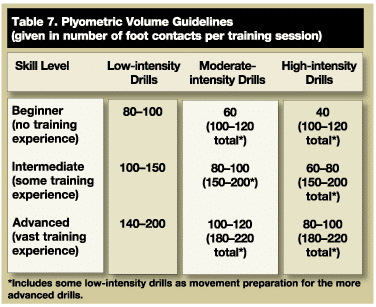
Summary
The purpose of the Functional Movement and Resistance Training (FMRT) component of the ACE IFT Model is to develop a systematic approach for designing an exercise program that can progress clients from the initial phases of stability and mobility training to the high-intensity exercises required to enhance muscle force production and power output. The first two phases of the FMRT focus on addressing postural imbalances and muscle motor control to help clients develop the necessary postural stability and proper movement sequences to allow for safe external loading for full-body movements. Clients with specific training goals, such as changes in body composition to increase lean muscle; improved muscular strength, or muscular endurance; or a desire to develop a more “toned” look, will want to progress to Phase 3 once they have adapted to the lower-intensity exercises and demonstrated success at adhering to a program. It is during the Load training phase that you will apply the current understanding of strength training to create and progress exercise programs to meet the many different needs of your clients. Phase 4 training is for clients with specific performance goals or who just want to challenge themselves with high-intensity power-based workouts. The client’s progress will dictate the exact application of the program-design variables and the length of time in each training phase.
To help facilitate client progress during all phases, reassess your clients’ fitness levels, goals and exercise programs on a regular basis and make appropriate adjustments as needed. This is important to facilitate continued goal achievement and new goal setting, which can help your clients avoid burnout or injury. It also provides a good mix of challenge and fun to keep motivation high. Finally, as clients improve their movement skill, strength and power output, they could incorporate group exercise and be encouraged to try strength training, boot camp or sports-conditioning classes to add variety to their routines.

____________________________________________________________
Pete McCall, M.S., has a Master’s of Science degree in exercise science and health promotion from California University of Pennsylvania and is an ACE-certified Personal Trainer.